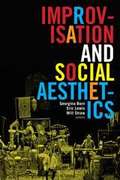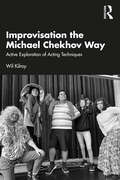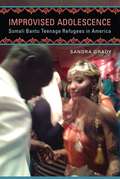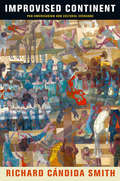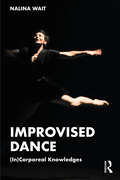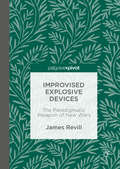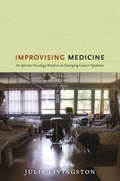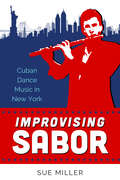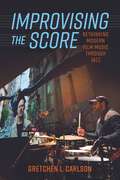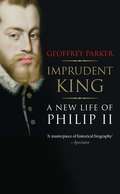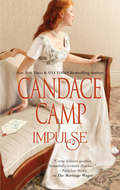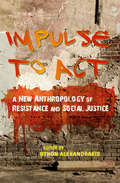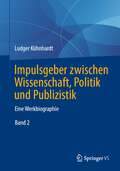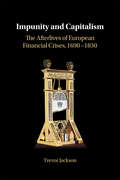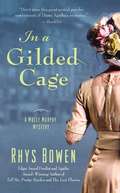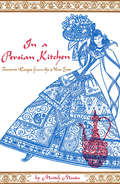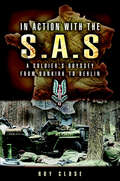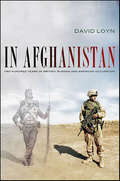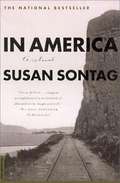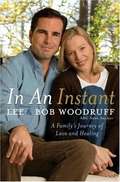- Table View
- List View
Improving the U.S. Military's Understanding of Unstable Environments Vulnerable to Violent Extremist Groups: Insights from Social Science
by David E. Thaler Gabriella C. Gonzalez Parisa Roshan Ryan Andrew Brown Blake W. MobleyFor over a decade, operations associated with irregular warfare have placed large demands on U. S. ground forces and have led to development of new Army and Joint doctrine. This report helps analysts identify and assess twelve key factors that create and perpetuate environments susceptible to insurgency, terrorism, and other extremist violence and instability to inform military decisions on allocation of analytic and security assistance resources.
Improvisation and Social Aesthetics
by Will Straw Georgina Born Eric LewisAddressing a wide range of improvised art and music forms—from jazz and cinema to dance and literature—this volume's contributors locate improvisation as a key site of mediation between the social and the aesthetic. As a catalyst for social experiment and political practice, improvisation aids in the creation, contestation, and codification of social realities and identities. Among other topics, the contributors discuss the social aesthetics of the Association for the Advancement of Creative Musicians, the Feminist Improvising Group, and contemporary Malian music, as well as the virtual sociality of interactive computer music, the significance of "uncreative" improvisation, responses to French New Wave cinema, and the work of figures ranging from bell hooks and Billy Strayhorn to Kenneth Goldsmith. Across its diverse chapters, Improvisation and Social Aesthetics argues that ensemble improvisation is not inherently egalitarian or emancipatory, but offers a potential site for the cultivation of new forms of social relations. It sets out a new conceptualization of the aesthetic as immanently social and political, proposing a new paradigm of improvisation studies that will have reverberations throughout the humanities.Contributors. Lisa Barg, Georgina Born, David Brackett, Nicholas Cook, Marion Froger, Susan Kozel, Eric Lewis, George E. Lewis, Ingrid Monson, Tracey Nicholls, Winfried Siemerling, Will Straw, Zoë Svendsen, Darren Wershler
Improvisation the Michael Chekhov Way: Active Exploration of Acting Techniques
by Wil KilroyImprovisation the Michael Chekhov Way: Active Exploration of Acting Techniques provides readers with dozens of improvisational exercises based on the acting techniques of Michael Chekhov. The book features key exercises that will help the actor explore improvisation and expand their imagination through the technique. Exercises that have been successfully taught for decades via the intensive trainings from the National Michael Chekhov Association are now clearly laid out in this book, along with information on how these performance-based techniques can be applied to a script and even provide life benefits. Guidance on how to use the exercises both in a group setting and as an individual is provided, as well as tools for lesson plans for up to a year of actor training. These step-by-step exercises will allow readers to expand their range of expression, discover the joy of creating unique characters, improve stage presence and presentation skills, and find new, creative ways to look at life. Improvisation the Michael Chekhov Way is written to be used by individual actors and practitioners and in group settings such as acting or improvisation courses, and to benefit anyone wishing to enhance their creativity and imagination.
Improvised Adolescence
by Sandra GradyChanging from child to young adult is difficult everywhere. But to experience childhood in continuous flight from conflict, then move into adolescence as a refugee in a radically different culture, is a more than usually complicated transition for teens and for their parents, communities, teachers, and social workers. Improvised Adolescence explores how teenagers from southern Somalia, who spent much of their childhood in East African refugee camps, are adapting to resettlement in the American Midwest. The collapse of the Somali state in 1991, and subsequent chaos in the Horn of Africa, disrupted the lives of these young people educationally, culturally, and developmentally. Folklorist Sandra Grady has intermittently observed the lifeworld of these teens--their homes, their entertainment choices, their interaction with classmates and teachers at school, and their plans for the future--for more than seven years to understand the cultural tools they've used in their journey from this disrupted childhood. They negotiate two sets of cultural expectations: in the resettled Somali Bantu community, traditional rites of passage continue to mark the change from child to adu
Improvised Continent: Pan-Americanism and Cultural Exchange
by Richard Cándida SmithHow does a country in the process of becoming a world power prepare its citizens for the responsibilities of global leadership? In Improvised Continent, Richard Cándida Smith answers this question by illuminating the forgotten story of how, over the course of the twentieth century, cultural exchange programs, some run by the government and others by philanthropies and major cultural institutions, brought many of the most important artists and writers of Latin America to live and work in the United States.Improvised Continent is the first book to focus on cultural exchange inside the United States and how Americans responded to Latin American writers and artists. Moving masterfully between the history of ideas, biography, institutional history and politics, and international relations, and engaging works in French, German, Spanish, and Portuguese, Cándida Smith synthesizes over seventy years of Pan-American cultural activity in the United States.The stories behind Diego Rivera's murals, the movies of Alejandro G. Iñárritu, the poetry of Gabriela Mistral, the photography of Genevieve Naylor, and the novels of Carlos Fuentes—these works and artists, along with many others, challenged U.S. citizens about their place in the world and about the kind of global relations the country's interests could allow. Improvised Continent provides a profoundly compassionate portrayal of the Latin American artists and writers who believed their practices might create a more humane world.
Improvised Dance: (In)Corporeal Knowledges
by Nalina WaitThis book elucidates the technical aspects of improvised dance performance and reframes the notion of labour in the practice from one that is either based on compositionally formal logic or a mysterious impulse, to one that addresses the (in)corporeal dimensions of practice. Mobilising the languages and conceptual frameworks of theories of affect, embodied cognition, somatics, and dance, this book illustrates the work of specialist improvisers who occupy divergent positions within the complex field of improvised dance. It offers an alternative narrative of the history and current practice of Western improvised dance centred on the epistemology of its (in)corporeal knowledges, which are elusive yet vital to the refinement of expertise. Written for both a disciplinary-specific and interdisciplinary audience, this book will interest dance scholars, students, and practising artists.
Improvised Explosive Devices
by James RevillThis book begins with an account of the evolution of improvised explosive devices using a number of micro case studies to explore how and why actors have initiated IED campaigns; how new and old technologies and expertise have been exploited and how ethical barriers to IED development and deployment have been dealt with. It proceeds to bring the evidence from the case studies together to identify themes and trends in IED development, before looking at what can realistically be done to mitigate the threat of IEDs in the new wars of the twenty first century. The book suggests that the advance and availability of a combination of technological factors, in conjunction with changes in the nature of contemporary conflicts, have led to the emergence of IEDs as the paradigmatic weapons of new wars. However their prevalence in contemporary and future conflicts is not inevitable, but rather depends on the willingness of multiple sets of actors at different levels to build a web of preventative measures to mitigate if not eradicate IED development and deployment. "
Improvising Medicine: An African Oncology Ward in an Emerging Cancer Epidemic
by Julie LivingstonIn Improvising Medicine, Julie Livingston tells the story of Botswana's only dedicated cancer ward, located in its capital city of Gaborone. This affecting ethnography follows patients, their relatives, and ward staff as a cancer epidemic emerged in Botswana. The epidemic is part of an ongoing surge in cancers across the global south; the stories of Botswana's oncology ward dramatize the human stakes and intellectual and institutional challenges of an epidemic that will shape the future of global health. They convey the contingencies of high-tech medicine in a hospital where vital machines are often broken, drugs go in and out of stock, and bed-space is always at a premium. They also reveal cancer as something that happens between people. Serious illness, care, pain, disfigurement, and even death emerge as deeply social experiences. Livingston describes the cancer ward in terms of the bureaucracy, vulnerability, power, biomedical science, mortality, and hope that shape contemporary experience in southern Africa. Her ethnography is a profound reflection on the social orchestration of hope and futility in an African hospital, the politics and economics of healthcare in Africa, and palliation and disfigurement across the global south.
Improvising Sabor: Cuban Dance Music in New York
by Sue MillerImprovising Sabor: Cuban Dance Music in New York begins in 1960s New York and examines in rich detail the playing styles and international influence of important figures in US Latin music. Such innovators as José Fajardo, Johnny Pacheco, George Castro, and Eddy Zervigón dazzled the Palladium ballroom and other Latin music venues in those crucible years. Author Sue Miller focuses on the Cuban flute style in light of its transformations in the US after the 1959 revolution and within the vibrant context of 1960s New York. While much about Latin jazz and salsa has been written, this book focuses on the relatively unexplored New York charangas that were performing during the chachachá and pachanga craze of the early sixties. Indeed, many accounts cut straight from the 1950s and the mambo to the bugalú’s development in the late 1960s with little mention of the chachachá and pachanga’s popularity in the mid-twentieth century. Improvising Sabor addresses not only this lost and ignored history, but contends with issues of race, class, and identity while evaluating differences in style between players from prerevolution Cuban charangas and those of 1960s New York. Through comprehensive explorations and transcriptions of numerous musical examples as well as interviews with and commentary from Latin musicians, Improvising Sabor highlights a specific sabor that is rooted in both Cuban dance music forms and the rich performance culture of Latin New York. The distinctive styles generated by these musicians sparked compelling points of departure and influence.
Improvising the Score: Rethinking Modern Film Music through Jazz
by Gretchen L. Carlson2023 Jazz Journalists Association (JJA) Jazz Awards for Books of the Year—Honorable Mention RecipientOn December 4, 1957, Miles Davis revolutionized film soundtrack production, improvising the score for Louis Malle’s Ascenseur pour l’échafaud. A cinematic harbinger of the French New Wave, Ascenseur challenged mainstream filmmaking conventions, emphasizing experimentation and creative collaboration. It was in this environment during the late 1950s to 1960s, a brief “golden age” for jazz in film, that many independent filmmakers valued improvisational techniques, featuring soundtracks from such seminal figures as John Lewis, Thelonious Monk, and Duke Ellington. But what of jazz in film today? Improvising the Score: Rethinking Modern Film Music through Jazz provides an original, vivid investigation of innovative collaborations between renowned contemporary jazz artists and prominent independent filmmakers. The book explores how these integrative jazz-film productions challenge us to rethink the possibilities of cinematic music production. In-depth case studies include collaborations between Terence Blanchard and Spike Lee (Malcolm X, When the Levees Broke), Dick Hyman and Woody Allen (Hannah and Her Sisters), Antonio Sánchez and Alejandro González Iñárritu (Birdman), and Mark Isham and Alan Rudolph (Afterglow). The first book of its kind, this study examines jazz artists’ work in film from a sociological perspective, offering rich, behind-the-scenes analyses of their unique collaborative relationships with filmmakers. It investigates how jazz artists negotiate their own “creative labor,” examining the tensions between improvisation and the conventionally highly regulated structures, hierarchies, and expectations of filmmaking. Grounded in personal interviews and detailed film production analysis, Improvising the Score illustrates the dynamic possibilities of integrative artistic collaborations between jazz, film, and other contemporary media, exemplifying its ripeness for shaping and invigorating twenty-first-century arts, media, and culture.
Imprudent King
by Geoffrey ParkerPhilip II is not only the most famous king in Spanish history, but one of the most famous monarchs in English history: the man who married Mary Tudor and later launched the Spanish Armada against her sister Elizabeth I. This compelling biography of the most powerful European monarch of his day begins with his conception (1526) and ends with his ascent to Paradise (1603), two occurrences surprisingly well documented by contemporaries. Eminent historian Geoffrey Parker draws on four decades of research on Philip as well as a recent, extraordinary archival discovery#151;a trove of 3,000 documents in the vaults of the Hispanic Society of America in New York City, unread since crossing Philip’s own desk more than four centuries ago. Many of them change significantly what we know about the king. The book examines Philip’s long apprenticeship; his three principal interests (work, play, and religion); and the major political, military, and personal challenges he faced during his long reign. Parker offers fresh insights into the causes of Philip’s leadership failures: was his empire simply too big to manage, or would a monarch with different talents and temperament have fared better?
Imprudent King: A New Life of Philip II
by Geoffrey ParkerPhilip II is not only the most famous king in Spanish history, but one of the most famous monarchs in English history: the man who married Mary Tudor and later launched the Spanish Armada against her sister Elizabeth I. This compelling biography of the most powerful European monarch of his day begins with his conception (1526) and ends with his ascent to Paradise (1603), two occurrences surprisingly well documented by contemporaries. Eminent historian Geoffrey Parker draws on four decades of research on Philip as well as a recent, extraordinary archival discovery--a trove of 3,000 documents in the vaults of the Hispanic Society of America in New York City, unread since crossing Philip's own desk more than four centuries ago. Many of them change significantly what we know about the king. Â The book examines Philip's long apprenticeship; his three principal interests (work, play, and religion); and the major political, military, and personal challenges he faced during his long reign. Parker offers fresh insights into the causes of Philip's leadership failures: was his empire simply too big to manage, or would a monarch with different talents and temperament have fared better?
Impulse
by Candace CampTorn from the arms of the woman he loved and cast into the night by her highborn family, Cam Monroe vowed revenge on those who had wronged him. Fifteen years later, after amassing a small fortune of his own, Cam returns to England with but one ambition. Now the power is his, power to ruin the Stanhope family if they refuse his demands. And what he demands is simple: that Angela Stanhope be his wife. Then the mysterious "accidents" begin. Are the Stanhopes trying once again to remove him from their lives? Or is it someone from Cam's past, someone desperate enough to kill to prevent him from uncovering a shocking lie?
Impulse to Act: A New Anthropology of Resistance and Social Justice
by Othon AlexandrakisWhat drives people to take to the streets in protest? What is their connection to other activists and how does that change over time? How do seemingly spontaneous activist movements emerge, endure, and evolve, especially when they lack a leader and concrete agenda? How does one analyze a changing political movement immersed in contingency? Impulse to Act addresses these questions incisively, examining a wide range of activist movements from the December 2008 protests in Greece to the recent chto delat in Russia. Contributors in the first section of this volume highlight the affective dimensions of political movements, charting the various ways in which participants coalesce around and belong to collectives of resistance. The potent agency of movements is highlighted in the second section, where scholars show how the emerging actions and critiques of protesters help disrupt authoritative political structures. Responding to the demands of the field today, the novel approaches to protest movements in Impulse to Act offer new ways to reengage with the traditional cornerstones of political anthropology.
Impulsgeber zwischen Wissenschaft, Politik und Publizistik: Eine Werkbiographie
by Ludger KühnhardtLudger Kühnhardt, weltweit tätiger Politikwissenschaftler, Berater und Publizist, gibt lebhafte und persönliche Einblicke in die Menschen und Quellen seiner Prägung, in die Denkwege, denen er gefolgt ist, und in die Impulse, die sein Wirken in Forschung und Lehre über Jahrzehnte hinweg ausgelöst hat. Ein biografischer Werkstattbericht von hoher Authentizität, der zusammenführt, was inmitten des beruflichen Alltags oft unverbunden erscheint. Immer wieder aus anderer Perspektive werden Einsichten beleuchtet, die ihrer Zeit voraus waren, und Befunde erinnert, die zeitlos aktuell geblieben sind. Eine lebendig geschriebene Werkbiographie über die inneren Antriebskräfte und äußeren Zusammenhänge eines kosmopolitischen public intellectual als aufklärerischer und beratender Impulsgeber im Wechselspiel von Wissenschaft, Politik und Publizistik. Das Buch spiegelt deutsche, europäische und globale Zeitgeschichte von der Mitte des 20.Jahrhunderts bis ins dritte Jahrzehnt des 21.Jahrhunderts in einem wissenschaftlichen Werk und seiner Einordnung als Zeugnis politischer Kultur.
Impunity and Capitalism: The Afterlives of European Financial Crises, 1690–1830
by Trevor JacksonWhose fault are financial crises, and who is responsible for stopping them, or repairing the damage? Impunity and Capitalism develops a new approach to the history of capitalism and inequality by using the concept of impunity to show how financial crises stopped being crimes and became natural disasters. Trevor Jackson examines the legal regulation of capital markets in a period of unprecedented expansion in the complexity of finance ranging from the bankruptcy of Europe's richest man in 1709, to the world's first stock market crash in 1720, to the first Latin American debt crisis in 1825. He shows how, after each crisis, popular anger and improvised policy responses resulted in efforts to create a more just financial capitalism but succeeded only in changing who could act with impunity, and how. Henceforth financial crises came to seem normal and legitimate, caused by impersonal international markets, with the costs borne by domestic populations and nobody in particular at fault.
Impurity of Blood: Defining Race in Spain, 1870-1930
by Joshua GoodeAlthough Francisco Franco courted the Nazis as allies during the Spanish Civil War in the late 1930s, the Spanish dictator's racial ideals had little to do with the kind of pure lineage that obsessed the Nazis. Indeed, Franco's idea of race -- that of a National Catholic state as the happy meeting grounds of many different peoples willingly blended together -- differed from most European conceptions of race in this period and had its roots in earlier views of Spanish racial identity from the late nineteenth and early twentieth centuries. In Impurity of Blood, Joshua Goode traces the development of racial theories in Spain from 1870 to 1930 in the burgeoning human science of anthropology and in political and social debates, exploring the counterintuitive Spanish proposition that racial mixture rather than racial purity was the bulwark of national strength.Goode begins with a history of ethnic thought in Spain in the medieval and early modern era, and then details the formation of racial thought in Spain's nascent human sciences. He goes on to explore the political, social, and cultural manifestations of racial thought at the dawn of the Franco regime and, finally, discusses its ramifications in Francoist Spain and post--World War II Europe. In the process, he brings together normally segregated historiographies of race in Europe.Goode analyzes the findings of Spanish racial theorists working to forge a Spanish racial identity in the late nineteenth and early twentieth centuries, when race and racial sciences were most in vogue across Europe. Spaniards devised their own racial identities using scientifically substantiated racial ideas and confronted head-on the apparent limitations of Spain's history by considering them as the defining characteristics of la raza española. The task of the Spanish social sciences was to trace the history of racial fusion: to study both the separate elements of the Spanish composition and the factors that had nurtured them. Ultimately, by exploring the development of Spanish racial thought between 1870 and 1930, Goode demonstrates that national identity based on mixture -- the inclusion rather than the exclusion of different peoples -- did not preclude the establishment of finely wrought and politically charged racial hierarchies. Providing a new comprehensive view of racial thought in Spain and its connections to the larger twentieth-century formation of racial thought in the West, Impurity of Blood will enlighten and inform scholars of Spanish and European history, racial theory, historical anthropology, and the history of science.
In A Gilded Cage (Molly Murphy Mystery #8)
by Rhys Bowen[From the back cover:] "thrilling historical events with truly beguiling characters under the most mysterious circumstances ... In a Gilded Cage Easter Sunday 1918, and Irish immigrant Molly Murphy has agreed to march down Fifth Avenue with tin. sign-wielding suffragettes from Vassar--a civil act of protest that lands her in jail. Molly's betrothed, Police Captain Daniel Sullivan, manages to spring her from the clink, though his hands are full dealing with Chinese opium gangs. But as soon as she's free, Molly marches straight into trouble again. Two of the Vassar alumni need Molly's help as a private investigator. One believes her uncle is cheating her out of an inheritance; the other suspects her husband is cheating with other women. And when one of the clients dies--presumably from influenza, which is sweeping the city--Molly takes to the streets once more. Not to win the right for women to vote, but to reveal the wrongs of some very evil men ..." Catch up on all of the investigations of a feisty Irish immigrant in early twentieth century New York City. The historic atmosphere is diverse and accurate and though Molly enjoys her independence and is out to prove women are capable of running a business, she has a soft spot for Daniel, a police captain who loves her, but not reliably. Look for #1 Murphy's Law, #2 Death of Riley, #3 For the Love of Mike, #4 In Like Flynn, #5 Oh Danny Boy, #6 In Dublin's Fair City, #7 Tell Me Pretty Maiden, with #9 The last Illusion, to be added soon. The ten books in the Evan Evans series, also by Rhys Bowen, about a constable in a mountainous Welsh town, are also in the collection.
In A Persian Kitchen
by Maideh MazdaWith colorful notes that reflect her family's traditions, Maideh Mazda offers readers the possibility of creating the delicate flavors of Persian cuisine. Maideh prioritizes economy and availability of ingredients, while at the same time offering wholly authentic recipes for such delicacies as Pomengranate Sauce, Ashe Reshte-a hearty beef noodle and lentil soup scented with cinnamon-and Ashe Torsh, a delicate dried fruit soup with cinnamon and mint. Notes on preparation and reflections on her experience of Persian food and eating customs growing up in a traditional Azerbijian household make this book "a pleasure to read" -The New York Times.
In Action with the S.A.S.: A Soldiers Odyssey from Dunkirk to Berlin (Reminiscence Ser.)
by Roy CloseA World War II memoir of a clerk who put down his pen and took up a weapon, rising through the ranks to become an elite Special Air Service soldier.Roy Close’s wartime experiences make breathtaking reading. Mobilized in 1939 he became part of the BEF and was fortunate to avoid death or captivity during the German blitzkrieg and escape through Dunkirk. Sent to North Africa, he joined the Paras and, from there, to the SAS. In 1944 he operated behind enemy lines with the Maquis in France, who were in open insurrection against the German occupiers. The scene then shifted to Holland and the advance through Germany. He witnessed Paris and Berlin in very early post-war years and was part of the Quadripartite Government of the former German capital.
In Afghanistan: Two Hundred Years of British, Russian and American Occupation
by David LoynAfghanistan has been a strategic prize for foreign empires for more than 200 years. The British, Russians, and Americans have all fought across its beautiful and inhospitable terrain, in conflicts variously ruthless, misguided and bloody. This violent history is the subject of David Loyn's magisterial book. It is a history littered with misunderstandings and broken promises, in which the British, the Russians, and later the Americans, constantly underestimated the ability of the Afghans. In Afghanistan brilliantly brings to life the personalities involved in Afghanistan's relationship with the world, chronicling the misunderstandings and missed opportunities that have so often led to war. With 30 years experience as a foreign correspondent, David Loyn has had a front-row seat during Afghanistan's recent history. In Afghanistan draws on David Loyn's unrivalled knowledge of the Taliban and the forces that prevail in Afghanistan, to provide the definitive analysis of the lessons these conflicts have for the present day.
In All Its Fury: The Story of the January 12th 1888 Blizzard
by W. H. O'Gara Ora A. ClementThis book is a compilation of the stories of "The Blizzard Club" members. It gives their first-hand accounts of how they survived the Blizzard of January 12, 1888. This blizzard is also known as "The Children's Blizzard", see book by the same name in Bookshare. It isn't a dry history text, but is instead a fascinating telling by the individuals who lived through it of a great natural disaster. The blizzard struck on a day that started calm, and unseasonably warm. Children went to school with light coats on. Around noon the blizzard stuck like a freight train, with black clouds coming extremely fast. Many students tried to get home and froze to death. Many farmers and livestock were also in the fields and froze to death because they could not see, or make it to safety. It is suggested by the History Channel that this blizzard was because of the dust that came from the volcano Krakatoa exploding. It is a blizzard that Laura Ingalls Wilder experienced, and could have written about in her books.
In All Things First: No. 1 Squadron at War 1939 - 45
by Peter CaygillIn All Things First' looks in detail at 1 Squadron during the Second World War with particular emphasis on the pilots and its operational activities. 1 Squadron was active from a very early stage when it flew to France on 8 September 1939 as part of the Advanced Air Striking Force and played a significant role in the Battle of France. Unlike most other squadrons that fought in France, it also played a major part in the Battle of Britain in 11 Group. Later in the war the Squadron had considerable success in the night intruder role and also took part in the defense against hit-and-run raiders. It was highly active over occupied Europe carrying out Rhubarb and Ramrod operations including the dive bombing of V-1 installations. When the V-1 campaign began 1 Squadron was the highest scoring Spitfire squadron. During the Second World War it flew the Hawker Hurricane from 1939-42 before converting to the Typhoon. In early 1944 it received Spitfire IXs and ended the war with the Griffon-powered Spitfire F.21. The main parts of the book are as follows: 1) Early Days—a brief look at the history of 1 Squadron up to 1939, 2) The First Team—pilot profiles, 3) The Phoney War—Blitzkrieg—The Withdrawal from France, 4) The Battle of Britain, 5) Sweeps and Circuses in 1941, 6) Night Intruders, 7) The Typhoon—combat with Fw 190 Jabos and Ramrods, 8) The Spitfire, 9) The V-1 Campaign and conversion to the Spitfire F.21, 10) The Post War Years—the No.1 Squadron story brought up to date. There will also be extensive appendices to include aircraft losses, details of selected operations and pilot escape and evasion.
In America: A Novel
by Susan SontagIn America is a kaleidoscopic portrait of America on the cusp of modernity. As she did in her enormously popular novel The Volcano Lover, Susan Sontag casts a story located in the past in a fresh, provocative light to create a fictional world full of contemporary resonance.<P><P> In 1876 a group of Poles led by Maryna Zalezowska, Poland's greatest actress, emigrate to the United States and travel to California to found a "utopian commune." When the commune fails, Maryna stays, learns English, and―as Marina Zalenska―forges a new, even more triumphant career on the American stage, becoming a diva on par with Sara Bernhardt.<P> In America is about many things: a woman's search for self-transformation; the fate of idealism; a life in the theater; the many varieties of love; and, not least of all, stories and storytelling itself. Operatic in the scope and intensity of the emotions it depicts, richly detailed and visionary in its account of America, and peopled with unforgettable characters.<P> In America is the winner of the 2000 National Book Award for Fiction.
In An Instant: A Family's Journey of Love and Healing
by Lee Woodruff Bob WoodruffThe co-anchor to ABC's World News Tonight suffered a brain injury that almost killed him - this is how his family coped with the tragedy.

